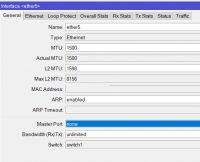Welcome to the beginning of the small schematic diagram of the network

I want to connect these two networks so that network 1 can access network 2 (server computers, devices).
Router in network 2 based on DDwrt, network 1 based on Mikrotik, which is configured for ports 1 and 3 without failover.
I made the physical connection from network 2 to 1 as follows:
From switch in network 2 to the Mikrotika port (ether 5).
On Mikrotik, I made the following configuration:
For port 5 I changed Master Port to none so that DHCP servers do not bite

Then I turned on the dhcp client for this port
Nicely downloaded ip address from network 2:
It also added to me from ip routes routing machine
It looks like this:
And after that I can ping the 192.168.2.0/24 network from the winbox terminal
Unfortunately, no device with 10.0.0.0/24 can be pinged to 192.168.2.0/24
Why is it like that?
What else should I do to be able to ping network 2 from devices 1 and thus connect to services?
Is the configuration / approach presented at all ok?
I drew an external address from the supplier because he doesn't need it.
If I have to provide something else, please write.

I want to connect these two networks so that network 1 can access network 2 (server computers, devices).
Router in network 2 based on DDwrt, network 1 based on Mikrotik, which is configured for ports 1 and 3 without failover.
I made the physical connection from network 2 to 1 as follows:
From switch in network 2 to the Mikrotika port (ether 5).
On Mikrotik, I made the following configuration:
For port 5 I changed Master Port to none so that DHCP servers do not bite

Then I turned on the dhcp client for this port
ip dhcp-client add interface=ether3 disabled=noNicely downloaded ip address from network 2:
[admin@MikroTik] > ip dhcp-client print
Flags: X - disabled, I - invalid
# INTERFACE USE-PEER-DNS ADD-DEFAULT-ROUTE STATUS ADDRESS
0 ;;; defconf
ether1 yes yes bound XXX.XXX.XXX.XXX/22
1 ether3 yes yes bound 192.168.1.100/24
2 ether5 yes yes bound 192.168.2.123/24
[admin@MikroTik] >
It also added to me from ip routes routing machine
It looks like this:
[admin@MikroTik] > ip route print
Flags: X - disabled, A - active, D - dynamic,
C - connect, S - static, r - rip, b - bgp, o - ospf, m - mme,
B - blackhole, U - unreachable, P - prohibit
# DST-ADDRESS PREF-SRC GATEWAY DISTANCE
0 A S 0.0.0.0/0 8.8.4.4 2
1 X S 0.0.0.0/0 8.8.8.8 1
2 A S 0.0.0.0/0 8.8.4.4 1
3 S 0.0.0.0/0 8.8.8.8 2
4 ADS 0.0.0.0/0 XXX.XXX.XXX.XXX 1
5 DS 0.0.0.0/0 192.168.2.1 1
6 DS 0.0.0.0/0 192.168.1.1 2
7 A S 8.8.4.4/32 192.168.1.1 1
8 SB 8.8.4.4/32 20
9 A S 8.8.8.8/32 XXX.XXX.XXX.XXX 1
10 SB 8.8.8.8/32 20
11 ADC 10.0.0.0/24 10.0.0.1 bridge 0
12 ADC 192.168.1.0/24 192.168.1.100 ether3 0
13 ADC 192.168.2.0/24 192.168.2.123 ether5 0
14 ADC XXX.XXX.XXX.0/22 XXX.XXX.XXX.XXX ether1 0
[admin@MikroTik] >And after that I can ping the 192.168.2.0/24 network from the winbox terminal
Unfortunately, no device with 10.0.0.0/24 can be pinged to 192.168.2.0/24
Why is it like that?
What else should I do to be able to ping network 2 from devices 1 and thus connect to services?
Is the configuration / approach presented at all ok?
I drew an external address from the supplier because he doesn't need it.
If I have to provide something else, please write.


